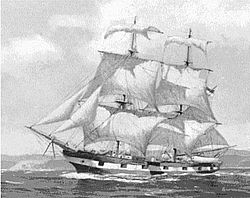- Chilean Brigantine Águila (1796)
-

Brigantine ÁguilaCareer (USA) 
Name: Eagle Operator: Smuggler Launched: 1796 Fate: confiscated by Spain Career (Spain) 
Name: Águila Operator: Spanish Navy Captured: 26. February 1817 Fate: Captured or handed over to Chile Career (Chile) 
Name: Águila Operator: Chilean Navy Commissioned: 26. February 1817 Renamed: Pueyrredón Honours and
awards:Participated in:
- Freedom Expedition Force to Perú
- Capture of Perla
Fate: sunk in Ancón District 1828 General characteristics Class and type: Brigantine Tons burthen: 220 t Armament: 16 guns Águila was the first naval vessel of the Chilean Navy.[1] She was later renamed Pueyrredón.
Contents
US time
She was the old US-smuggler Eagle,[2] a 220 tons brig and sixteen guns[3]:page 422 launched in England in 1796.[4]
Spanish career
Coming from Buenos Aires without documents or license with a contraband of lingerie the ship was captured by the Spaniards in Coquimbo but this capture was not informed to the Spanish Navy in Callao. The ship with the new crew sailed to then Spanish Valparaíso and refitted as a 50-gun ship and was put under the command of Spanish Captain José Anacleto Goñi and manned with 50 Chileans (in Spanish originarios).[5](p104ff) The next time the ship was seen in Paita on November 1816 and few days later sailed, allegedly, to the port of destination Galápagos. The Spanish commandant of Callao, Antonio Vacaro, was informed from Paita about this new ship in his naval division, but due to the circumstances he mistrusted Captain Goñi and his crew. Moreover he learnt that the real destination of the ship was Panama City. Consequently he ordered the commandants of the ports of Guayaquil and Paita to replace Goñi by a trustworthy captain, to man the ship with at least 2/3 Spaniards (in Spanish europeos) and to send the ship immediately to Callao on its return from Panama.
The Spanish author Gaspar Pérez Turrado supposes that Goñi was a supporter of the Chilean Independence and that as he learnt about the triumph of the Chileans he sailed to Valparaíso in order to hand the ship over to the revolutionaries.[5](p105)
Chilean career
Meanwhile, after the defeat in the Battle of Chacabuco (February 12, 1817) the Spaniards lost the control of Valparaíso albeit they were able to blockade the port temporarily with the ships Esmeralda and Pezuela.
On 26 February 1817[1] the ship entered Valparaíso and the Chilean Authority assumed the command over the ship. Some sources assert that the ship was captured by the Chileans.[1][2] Anyway, she came under the command of Raymond Morris an Irish mercenary and former lieutenant in the British Royal Navy.[6](p406)
The ship sailed on 17 March 1817 to rescue a group of 78 Chilean patriots being held prisoners in the Juan Fernández Islands and came back to Valparaíso fourteen days later.[7] The group included Manuel Blanco Encalada, who subsequently led the Navy and, in later years, became the first President of Chile and Francisco de la Lastra later Intendant of Santiago and Privy Councillor. As such, he became temporary Supreme Director.
On 14 Juli 1818[4] she had been renamed Pueyrredón to honour the Argentine Juan Martín de Pueyrredón, Supreme Director of the United Provinces of the Río de la Plata who strongly supported the independence of Chile.
She captured on 8. October 1818 the Spanish corvette Perla (Ex-US-Pearl).[4]
On 9 October 1818 sailed from Valparaíso with others ships to deter a Spanish expedition from Cadiz made up of eleven transports and the, then Spanish frigate María Isabel. It carried 2000 soldiers as well as weapons, ammunition, and supplies to reinforce the Viceroyalty of Perú. The Chilean squadron under commander Blanco Encalada captured on 28. October the María Isabel in Talcahuano and also on 11 November 1818 the Dolores, Magdalena, Elena, Jerezana und Carlota in the Santa Maria Island.[5](p116ff)
On 16 January 1819 sailed from Valparaíso the First Chilean Navy Squadron, under the command of Admiral Lord Thomas Alexander Cochrane to the first blockade of the Callao, later followed the (now called) Pueyrredón, Galvarino and Araucano under the command of Blanco Encalada. In Juni were all the Chilean ships back in Valparaíso.
On 12. September 1819 sailed Cochrane and Blanco Encalada again to the second blockade of Callao with a squadron composed of O'Higgins, San Martín, Lautaro, Independencia, Galvarino, Araucano and Pueyrredón.
The Pueyrredón was used to shell the Callao with the Congreve rocket and later ordered to Guayaquil to search for the Spanish Prueba.[5](p143). In December 1819 were most of the Chilean ships back in Valparaíso, as the Pueyrredón also.
On 21 August 1820 sailed the Freedom Expedition Force of Peru with the Pueyrredón under the ships of the squadron.
On 28. September 1821 despite Cochrane's efforts to retrieve the ship, she sunk in Ancón.[6](p157)
References
- ^ a b c Website of the Chilean Navy, retrieved 7. January 2011
- ^ a b historical text archive retrieved 7. January 2011
- ^ David Marley, Wars of the Americas: a chronology of armed conflict in the New World, 1492 to the present, ABC-CLIO, 1998, url
- ^ a b c Web site of the Chilean Navy Unidades Navales Históricas, retrieved 12. January 2011
- ^ a b c d Gaspar Pérez Turrado, Las Marinas realista y patriota en la independencia de Chile y Perú, Ministerio de Defensa, Madrid, España, 1996, ISBN 84-7823-496-9
- ^ a b Carlos Lopez Urrutia, Historia de la Marina de Chile, Ed. Andrés Bello, url
- ^ Biography of Blanco Encalada retrieved on 7 January 2011
Categories:- First Chilean Navy Squadron
Wikimedia Foundation. 2010.
